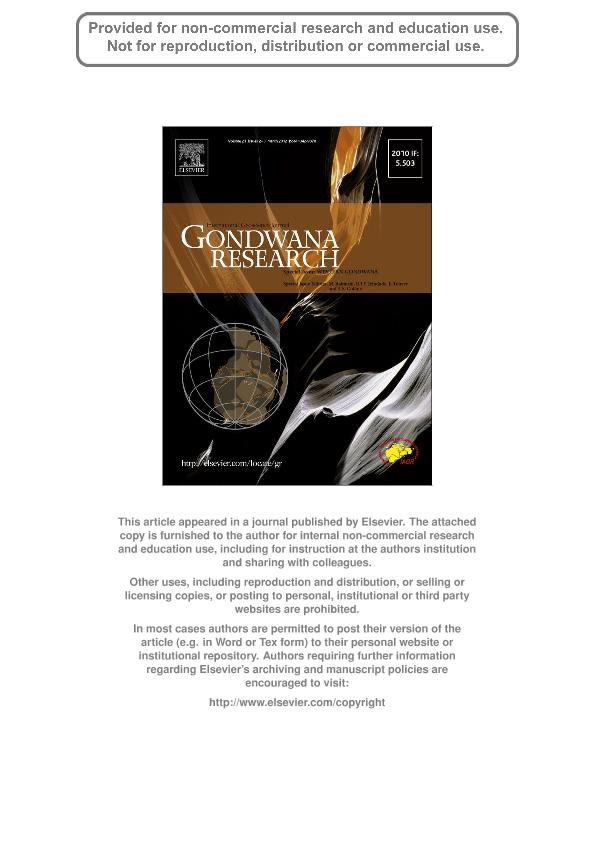Mostrar el registro sencillo del ítem
dc.contributor.author
Chernicoff, Carlos Jorge

dc.contributor.author
Zappettini, Eduardo Osvaldo

dc.contributor.author
Santos, João O. S.
dc.contributor.author
Godeas, Marta Carmen

dc.contributor.author
Belousova, E.
dc.contributor.author
McNaughton, Neal J.
dc.date.available
2023-04-20T17:18:06Z
dc.date.issued
2012-03
dc.identifier.citation
Chernicoff, Carlos Jorge; Zappettini, Eduardo Osvaldo; Santos, João O. S.; Godeas, Marta Carmen; Belousova, E.; et al.; Identification and isotopic studies of early Cambrian magmatism (El Carancho Igneous Complex) at the boundary between Pampia terrane and the Río de la Plata craton, La Pampa province, Argentina; Elsevier Science; Gondwana Research; 21; 2-3; 3-2012; 378-393
dc.identifier.issn
1342-937X
dc.identifier.uri
http://hdl.handle.net/11336/194787
dc.description.abstract
We have identified late Early Cambrian metaigneous rocks very poorly exposed at the Estancia El Carancho, in central La Pampa province, Argentina. They comprise calc-alkaline metadiorite and metagranite, and tholeiitic metapyroxenite and metagabbro. They are jointly referred to as the El Carancho Igneous Complex, and regarded to pertain to the Pampean magmatic arc and backarc, respectively. Titanite U-Pb SHRIMP dating of the metapyroxenite yielded 528±5Ma, and zircon U-Pb SHRIMP dating of the metadiorite yielded 520±1.4Ma. Hafnium isotope determinations on the dated zircons show 176Hf/177Hf ratios corresponding to positive εHf values from +7.18 to +9.37; Hf model ages of the Cambrian zircons yielded 884Ma. It is interpreted that the metadiorites of the Complex crystallized from an Early Neoproterozoic (Tonian) juvenile source. We argue that the inferred occurrence of juvenile Tonian magmatic rocks in the (otherwise, mostly Paleo-Mesoproterozoic) substratum of the southern Pampia terrane could indicate a zone of thinned basement possibly associated with the early stage of Rodinia's breakup. In addition, the studied segment of the Pampean magmatic arc is contaminated by also juvenile, Late Mesoproterozoic crust, as evidenced by the presence of xenocrystic cores of 1140-1194Ma - TDM-Hf 1720Ma and εHf values of +3.24 to +4.85 - in the Cambrian zircons, hence suggesting that the studied segment of the Pampean magmatic arc was intruded into juvenile Late Mesoproterozoic magmatic arc rocks. The El Carancho Igneous Complex would be located at the tectonic boundary between the Pampia terrane and the Río de la Plata craton. This boundary stands out in the aeromagnetic data as a change in the structural orientation about a roughly N-S line located approximately at 65° W and representing the suture zone between the Pampia terrane and the Río de la Plata craton. Our geotectonic model envisages westward dipping subduction of oceanic crust beneath the Pampia terrane; the El Carancho Igneous Complex would, therefore, have been originated on the Pampia side (upper plate) of the suture. Slivers of the arc- and backarc-type rocks would have been tectonically imbricated in the suture zone during the Pampean orogeny.
dc.format
application/pdf
dc.language.iso
eng
dc.publisher
Elsevier Science

dc.rights
info:eu-repo/semantics/openAccess
dc.rights.uri
https://creativecommons.org/licenses/by-nc-sa/2.5/ar/
dc.subject
AEROMAGNETICS
dc.subject
HF ISOTOPES
dc.subject
LA PAMPA PROVINCE
dc.subject
PAMPEAN MAGMATIC ARC-BACKARC
dc.subject
U-PB SHRIMP
dc.subject.classification
Geología

dc.subject.classification
Ciencias de la Tierra y relacionadas con el Medio Ambiente

dc.subject.classification
CIENCIAS NATURALES Y EXACTAS

dc.title
Identification and isotopic studies of early Cambrian magmatism (El Carancho Igneous Complex) at the boundary between Pampia terrane and the Río de la Plata craton, La Pampa province, Argentina
dc.type
info:eu-repo/semantics/article
dc.type
info:ar-repo/semantics/artículo
dc.type
info:eu-repo/semantics/publishedVersion
dc.date.updated
2023-04-19T15:26:36Z
dc.journal.volume
21
dc.journal.number
2-3
dc.journal.pagination
378-393
dc.journal.pais
Países Bajos

dc.journal.ciudad
Amsterdam
dc.description.fil
Fil: Chernicoff, Carlos Jorge. Secretaría de Industria y Minería. Servicio Geológico Minero Argentino; Argentina. Consejo Nacional de Investigaciones Científicas y Técnicas; Argentina
dc.description.fil
Fil: Zappettini, Eduardo Osvaldo. Secretaría de Industria y Minería. Servicio Geológico Minero Argentino; Argentina
dc.description.fil
Fil: Santos, João O. S.. University of Western Australia; Australia
dc.description.fil
Fil: Godeas, Marta Carmen. Secretaría de Industria y Minería. Servicio Geológico Minero Argentino; Argentina
dc.description.fil
Fil: Belousova, E.. Macquarie University; Australia
dc.description.fil
Fil: McNaughton, Neal J.. University of Western Australia; Australia
dc.journal.title
Gondwana Research

dc.relation.alternativeid
info:eu-repo/semantics/altIdentifier/doi/http://dx.doi.org/10.1016/j.gr.2011.04.007
Archivos asociados
